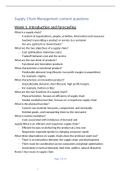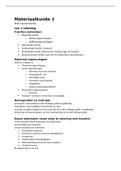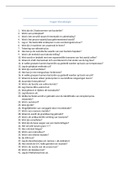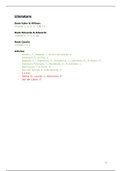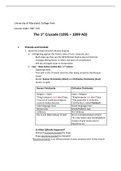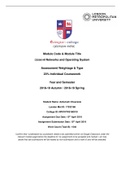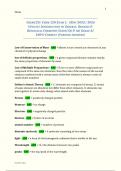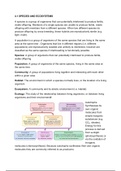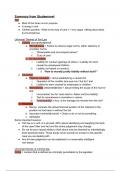Supply Chain Management content questions
Week 1: Introduction and forecasting
What is a supply chain?
- A system of organizations, people, activities, information and resources
involved in providing a product or service to a customer
- Are you upstream or downstream?
What are the two objectives of a supply chain?
- Cost optimization (minimize costs)
- Tradeoff between cost and the service
What are the two kinds of products?
- Functional and innovation products
What characterizes a functional product?
- Predictable demand, long lifecycle, low profit margins (competition)
- For example, staples
What characterizes an innovation product?
- Unpredictable demand, short lifecycle, high profit margins
- For example, fashion or B&J
What are the two functions of a supply chain?
- Physical function, focuses on efficiency of supply chain
- Market mediation function, focuses on a responsive supply chain
What is the physical function?
- Convert raw material into parts, components, and eventually
finished goods, and transporting them to the next point
What is market mediation?
- Costs associated with imbalance of demand and
supply What is an efficient and responsive supply chain?
- Efficient focuses on delivering the product at a low cost
- Responsive responds quickly to changing consumer needs
What three observations on supply chains does the professor point out?
- There is an interaction between the supply chain and development
- There must be coordination across companies and global optimization
- Uncertainty is normal (demand, lead time, politics, natural disasters)
Name 5 key issues in supply chain
Page 1 of 37
->
, lOMoARcPSD|15781725
- Inventory control
- Network configuration
- Production sourcing
- Supply contracts
- Distribution strategies
- Product design
- Supply chain integration and partnering
Why is forecasting relevant? To what areas?
- Capacity, a shortage in your product can lead to loss of customers
or market share
- Workforce scheduling, know when you hire and fire
- Have a good relation with your suppliers, by sharing relevant forecasts
What are the seven steps to forecasting?
- Determine use of forecast
- Select items to be forecasted
- Determine time horizon of forecast
- Select forecasting model
- Gather data
- Make the forecast
- Implement results
What are the 3 golden rules?
- Forecasts are always wrong
- The longer the forecast horizon, the worst the forecast
- Aggregate forecast are more accurate (forecast car sales in 1y better
than forecasting car sales for tomorrow)
What are aggregate forecasts
- You should rather use forecasts backed by a significant amount of data,
than do forecasts with very low data in them
When do we use qualitative methods to forecast?
- When a new product or new technology, no data on it
Mention methods of qualitative forecasts
- Jury of executive opinion: pool opinion of high level experts
- Delphi method: panel of experts discuss
- Sales force composition: estimates form individual salespersons
- Consumer market survey: ask customers directly
Page 2 of 37
->
, lOMoARcPSD|15781725
When do we use quantitative forecasting methods?
- Stable situation and historical data exists
What are time series models?
- Naïve approach - I sold 250 iPhone in January. I forecast a demand of
250 for February
- Moving average
- Exponential smoothing
- Seasonal index - how a particular season compares with average season
of that cycle
Why do we deseasonalize data?
- To remove seasonal fluctuations to predict approximate future data
values
What is the naïve approach?
- We assume there is no trend, demand in previous period is the same as
demand in the recent periods
- Is cost effective and efficient
What is the moving average approach?
- Used if there is little to no trend
- Always runs a bit behind
What are potential problems with moving average?
- Does not forecast trends
- Requires extensive historical data
- Increases “n” does smoothen the data but is less sensitive to changes
What is exponential smoothing?
- Takes into account recent observations (flexibility) and historical data
(stability)
What does 𝛼 represent in your ES formula?
- It is the smoothing parameter that defines the weighting and
stands between 0 and 1
What does a high 𝛼 mean in ES?
- A high value of 𝛼 tracks the data more closely by giving more weights to
recent data
What is seasonal variation?
- Consistent up and down movements of data
What is seasonality adjustment or deseasonalizing the data?
Page 3 of 37
->
, lOMoARcPSD|15781725
- Removes seasonal effects and useful to identify other patterns
What is forecast error?
- The difference between the actual demand and forecasted demand
How do you measure the error?
- Through measures of accuracy (MAD, MSE, MAPE)
What is the purpose of MAD, MSE and MAPE?
- Compare the fits of different forecasting and smoothing methods
What do MAD, MSE and MAPE stand for?
- Mean Absolute Deviation - average the error
- Mean Squared error - average of squared forecast error- Squaring forces
values to be positive and puts more weight on large errors
- Mean Absolute Percentage Error - sum of the individual absolute errors
divides by the demand, the average of the percentage error
What are measures of bias?
- Tells you if the forecast is consistently too high or too low
What if the tracking signal (TS) is negative?
- Demand is on average too low
- Your forecasts are too high
What if tracking signal (TS) is positive?
- Demand is on average too high
- Your forecasts are too low
Week 2: Inventory management and risk pooling
Why does it become more expensive to store a product in inventory when we
move downstream?
- Costs - Additional costs are put in the product, such as labor
- Storing - It is more difficult to further change the product, and store it by
piece
Why do we hold inventory?
- Hedge against uncertainty. We do not know what next demand will
be or if our supplier will not default
- Take advantage of economies of scale
Page 4 of 37
->

